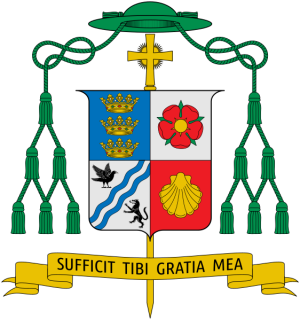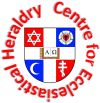Héctor Felipe Vila: Difference between revisions
Knorrepoes (talk | contribs) m (Text replacement - "{{religion}}" to "") |
Knorrepoes (talk | contribs) No edit summary |
||
| (9 intermediate revisions by the same user not shown) | |||
| Line 1: | Line 1: | ||
{| class="wikitable" | |||
|- style="vertical-align:top;" | |||
| | |||
<center>''' {{uc:{{PAGENAME}}}} '''</center><br> | |||
'''Born''': September 17, 1962<br> | |||
''' | '''Deceased''': | ||
Deceased : | |||
Bishop of [[Diocese of Whitehorse|Whitehorse]], 2015-present | Bishop of [[Diocese of Whitehorse|Whitehorse]], 2015-present | ||
| | |||
[[File:whitehorse-vila.png|center|300 px|Arms (crest) of {{PAGENAME}}]] | |||
|} | |||
{| class="wikitable" | |||
|+Official blazon | |||
|- | |||
|'''English''' | |||
| blazon wanted | |||
|} | |||
===Origin/meaning=== | ===Origin/meaning=== | ||
The three crowns refer to the three wise men who journeyed afar to encounter the Infant Jesus in Bethlehem. But it also is a sign of the birthplace of the Bishop, Lima (Peru), since it is said that Francisco Pizarro, the founder of the city gave the name "City of Kings" to the new capital on the feast day of the Epiphany. | The three crowns refer to the three wise men who journeyed afar to encounter the Infant Jesus in Bethlehem. But it also is a sign of the birthplace of the Bishop, Lima (Peru), since it is said that Francisco Pizarro, the founder of the city gave the name "City of Kings" to the new capital on the feast day of the Epiphany. | ||
| Line 25: | Line 31: | ||
The motto ''Sufficit Tibi Gratia Mea'' means My grace is sufficient for you. | The motto ''Sufficit Tibi Gratia Mea'' means My grace is sufficient for you. | ||
{{ | {{religion}} | ||
{{ | {{media}} | ||
[[Literature]] : http://www.whitehorsediocese.ca | [[Heraldic literature - Ecclesiastical heraldry|'''Literature''']]: http://www.whitehorsediocese.ca | ||
[[Category:Roman Catholic bishops|Vila]] | [[Category:Roman Catholic bishops|Vila]] | ||
Revision as of 07:20, 7 July 2024
|
Born: September 17, 1962 Bishop of Whitehorse, 2015-present |
| English | blazon wanted |
Origin/meaning
The three crowns refer to the three wise men who journeyed afar to encounter the Infant Jesus in Bethlehem. But it also is a sign of the birthplace of the Bishop, Lima (Peru), since it is said that Francisco Pizarro, the founder of the city gave the name "City of Kings" to the new capital on the feast day of the Epiphany.
The rose symbolizes the virgin of Guadalupe to whom he Diocese of Whitehorse is consecrated. Our lady of Guadalupe is also venerated in the Parish where the Bishop lived in Toronto during many years.
The shell is an ins trument that was traditionally used to pour Water during the sacrament of baptism. It becomes a reference that, as children of God, starting at baptism, we are pilgrims that journey to the house of God. This pilgrimage is never ending until we reach the Father's heart.
The wavy bends refer to the rapids of the city of Whitehorse which represent the people of Whitehorse.The wolf and the raven are traditional symbols of the two main clans in Whitehorse's First Nations communities.
The cross behind the shield recalls the one used by the communities of the Neocatechumenal Way where throughout the years the Bishop has learned to grow in faith.
The motto Sufficit Tibi Gratia Mea means My grace is sufficient for you.
Religious or Ecclesiastical heraldry portal
This page is part of the Ecclesiastical heraldry portal |
Heraldry of the World |
|
Catholic heraldry
|
Other Christian churches Other religions
|
Contact and Support
Partners:
Your logo here ?
Contact us
© since 1995, Heraldry of the World, Ralf Hartemink 
Index of the site












